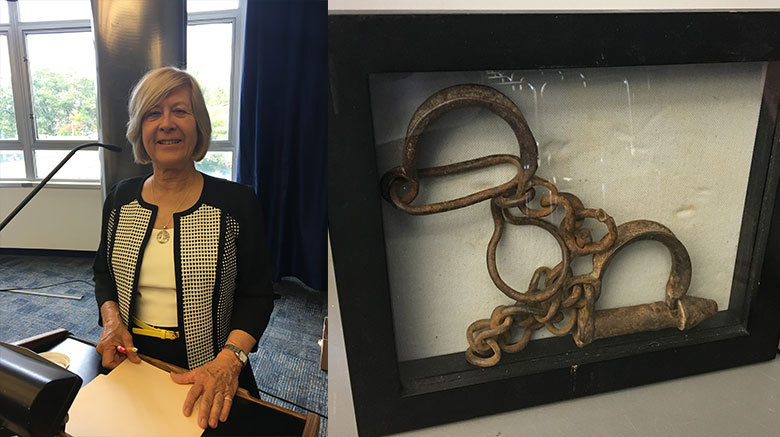When it comes to discussing uncomfortable topics or issues that require a little research to get to the truth, society tends to have what Dr. Barbara Rippel, professor emerita at Suffolk County Community College, calls “unconscious amnesia.”
One of those painful topics continues to be slavery.
At SJC Long Island’s ninth annual history lecture, Dr. Rippel spoke about “The African-American Experience on Long Island: The Heritage of Slavery,” explaining a disturbing time in history for New Yorkers.
“How Americans do history is that stories are usually written by the winners,” Rippel said. “In the last 20 years, we have tried to remedy that.”
Many northerners have an understanding that slavery was a southern problem, but in the 17th century, when Long Island was first settled, there were almost 2,000 slaves in New York, which was greater than the number of slaves in all of the New England states combined, Rippel noted. During that time, half of the slaves in New York were on Long Island., where there were African-American and Native-American slaves, she said.
Rippel told the story of the Sylvester family, who in 1651 built an estate on Shelter Island, an island nestled between the north and south forks of eastern Long Island. The family’s sprawling estate covered most of the 8,000 acres of the island, and the farm on their land was used to provide food for the slaves at the family’s sugar plantations in Barbados. Nathaniel Sylvester is believed to be the first person to bring slaves to Suffolk County.
According to the New York Times, when Nathanial Sylvester died in 1680, his will included 23 servants, making Sylvester Manor the largest slaveholding property on Long Island at the time. This number did not include the many Native American servants he also employed to work his land. The Manor was eventually passed down through 11 generations of Sylvesters, until 2014 when 225 acres of the estate was donated to create Sylvester Manor Educational Farm, a non-profit organization that grows organic produce and teaches sustainable farming methods.
Rippel also discussed Jupiter Hammon who during the 18th century was a slave for the Lloyd Family, the namesake for Lloyd Harbor on the North Shore. His father could read and write, so he was encouraged by the Lloyd family to attend school and do the same. As an educated servant, Hammon negotiated trade deals alongside the head of the Lloyd family.
“Jupiter could read and write … this was not common for African-American slaves,” Rippel said. “He would become the first African-American to be published in the United States.”
In 1799, New York State started to enforce the Gradual Emancipation Act where African-Americans were slowly freed from indentured servitude, Rippel said. Not all white households followed the new ruling and most slaves were still owned until the abolishment of slavery was declared in New York on July 4, 1827.
Rippel noted that in Rocky Point, in the early 1800s, there is evidence of Betsey Prince, a free black woman who lived in a modest house that was the center of a small community of free African-American farmers. Census documents from 1820 indicate the Prince residence and surrounding households were listed as one of only two free African-American neighborhoods in the Town of Brookhaven.
In the 1990s, many artifacts were found during an excavation to widen NYS Route 25A. Today, a blue sign from the William G. Pomeroy Foundation stands at the site designating it as a historic location. It’s likely that many of the African-Americans living as free citizens in Rocky Point in the early 1800s had previously lived in the area as slaves, Rippel said.
“Freed slaves typically resided in close proximity to the location where they had been enslaved,” Rippel said.
Rippel said her research of the African-American experience on Long Island has led her to motivate others to think more carefully about their place in society.


